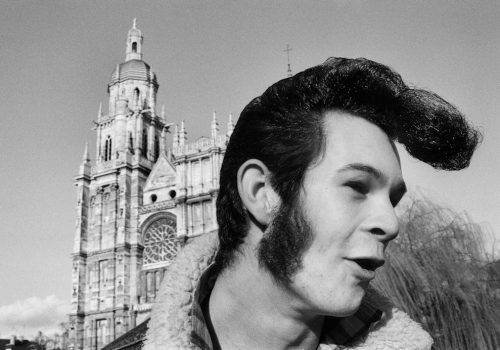Evreux, 1982. For four months, the photographer trailed Marco, Raynald, Michel, Eric, Boumé, Lionel, Titi, Denis, Alan, Jimmy, Bouboule, and others. This black-and-white series is today on display at 106 in Rouen. Gil Rigoulet tells The Eye of Photography this wonderful story tangled up in rock & roll.
At the time, I lived in Evreux. I had contributed to the weekly, La Dépêche since 1975, and I was starting to sell my photos to Parisian newspapers (like Libération) and magazines. I hung around with friends who had formed rock bands and, since the 1970s, I regularly traveled to London to go to festivals and rock clubs, like the Marquee, which hosted The Who, David Bowie, Jethro Tull, The Moody Blues, Jimi Hendrix, Pink Floyd, Joe Cocker, The Sex Pistols, The Police, Guns N’ Roses, The Cure…
It was on a brisk winter day in 1982, near the waterfront where you can see the Evreux cathedral, that I first came across that greased-up pompadour, like a giant banana on a stick. It made me think of the comic strip character, the rocker Lucien, a brainchild of the illustrator Margerin. Without any ado, I came up to the group, with their Teddy Boy hairdos, and proposed to follow them on their outings. They all lived in the Saint-Michel low-rises, those big housing developments in the Madeleine district. Most were working-class. I pitched the idea to Jean Louis, the editor-in-chief at La Dépêche, and got a green light.
These rockabillies were a gang of friends, they were in touch with the revival of the Teddy Boy movement in England which had started around 1972–75. They had pals in Rouen and got together at the Liberty Bar (which went back to the American presence on the airbase in Evreux), and then would go dancing at Ranch Jularedo out in the sticks.
For four months, I trailed Marco, Raynald, Michel, Eric, Boumé, Lionel, Titi, Denis, Alan, Jimmy, Laurent, Bouboule, and others: in their bedrooms, with their parents, at Tuffier’s hair salon, at work, at the King Bee, the record dealer, at the marketplace where they got their gear, and on their rides at night.
I approached this group with the idea of doing an in-depth reportage, delving into details, learning where they came from by going home with them. Many of them still lived with their parents; they spent their time at the hairdresser’s, in parking lots where they tinkered with their cars, or they had jobs, but I was quickly locked out of their workplaces, except for an antiquated laundry that allowed me in.
For the most part, these guys were workers, and spent their free time listening to music — Gene Vincent, Elvis Presley, Crazy Cavan and the Rhythm Rockers — and dreamed of traveling to the United States: the cars, the clubs in the South of the US, the pin-up girls in stilettos and sexy skirts. They hung around the record dealer “King Bee,” listening to vinyls imported from America.
In addition to their well-groomed look, they were pimping up their old Simca Chambords, Versailles, or Arondes to look like American models. The rest of the week, it was punching the clock in and out, then coffee after work at their hangout bar.
My position as a photographer for a well-known local weekly, and my interest in the gang, helped me win them over. They were probably sounding me out… I followed them around with my journalist friend, Yves. But to take photos, I spent more time with them. This allowed us to get to know each other better, and I think that, eventually, me and my Nikon F just blended in with the background.
I know how to be a fly on the wall, to become almost invisible, while being very focused on my images; but I also know how to speak up at the right moment, and then fade away just as quickly. The bond between us was forged tacitly, and from the journalist who got in touch with them I became someone they knew and trusted.
I could stop by their houses, photograph their bedrooms, and sometimes even have lunch with their parents. After several weeks, they got into the habit of giving me a heads up when they were going out. Visits to the hairdresser were of utmost importance; the salon was run by Mr. Tuffier, a bespectacled 70-year-old sporting a goatee and a big floral necktie. He did magic with the pompadours, a real artist!
One night, I had just filled up my car at the famous Mobil gas station in Evreux, known for being the only one in town open late, where you could buy beer after sundown… A cavalcade of Citroën DS, Chambords, Aronds was filing in the direction of Ranch Julerado in Coudray, in the Vexin region, sixty mile-markers along country roads. Cats scampered out of the way and dogs howled at the moon in every town we passed. The V8 engines in Simca Versailles purred away, but they had to slow down to let the Arondes catch their breath…
The road stretched on and the beer was running low, so a whole ballet was being staged in motion, people passing the last cans through car windows, until we reached the godforsaken village, home to the Ranch Jularedo dancing club, where Little Richard still played from the jukebox.
Gil Rigoulet
Gil Rigoulet is a French photographer who began his career in 1975 and has worked for major French and international newspapers for over three decades.
Gil Rigoulet, Rockabilly ’82
January 24 to March 24, 2018
Le 106
Quai Jean de Béthencourt
76000 Rouen
















